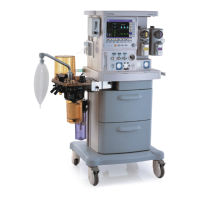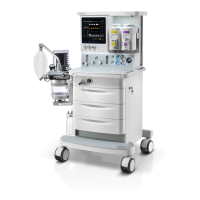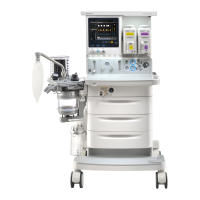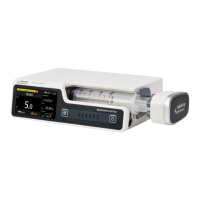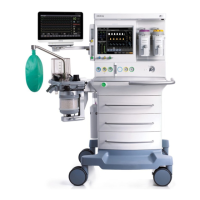Do you have a question about the Mindray ePM 10M and is the answer not in the manual?
| Display Type | TFT LCD |
|---|---|
| Battery Life | 4 hours |
| Connectivity | Ethernet |
| Parameters Monitored | ECG, SpO2, NIBP, RESP, TEMP |
| ECG | 3/5-lead |
| SpO2 | Yes |
| NIBP | Yes |
| Alarm System | Audible and visual alarms |
| Power Supply | AC 100-240V, 50/60Hz |
| Display Size | 10.1-inch |
Provides critical warnings about equipment usage, electrical hazards, patient safety, and proper operation.
Details cautions regarding accessory use, power supply, environmental factors, and disposal of equipment.
Covers essential steps for preparing the monitor, connecting power, and initial setup procedures.
Explains how to power on the monitor, use the touchscreen, and navigate through menus and quick keys.
Details the different areas of the monitor's screen display, including patient info, alarms, and parameter areas.
Provides instructions and safety precautions for properly shutting down the patient monitor.
Covers editing, loading, exporting, and deleting patient data for effective patient management.
Details how to manage monitor settings, change departments, and save user configurations for optimal performance.
Explains alarm categories, priorities, indicators, and status symbols for effective alarm management.
Provides guidance on adjusting parameter alarm properties, tone properties, and auto limits for new patients.
Details procedures for pausing alarms, alarm sounds, and resetting the alarm system.
Covers safety precautions for ECG monitoring, patient skin prep, and electrode application.
Explains how to adjust ECG screen, alarm properties, analysis modes, and waveform settings for optimal monitoring.
Details arrhythmia analysis, ST segment monitoring, and QT/QTc interval monitoring procedures.
Provides solutions for common ECG monitoring problems like noisy signals, lead-off, and low amplitude.
Covers respiration monitoring preparation, display, and changing settings for accurate measurements.
Details SpO2 monitoring preparation, safety, limitations, display, and changing settings.
Provides guidance on preparing for temperature monitoring and changing related settings.
Covers NIBP monitoring introduction, safety, measurement modes, display, preparation, and settings.
Details IBP monitoring preparation, safety, zeroing transducers, and changing IBP settings.
Covers C.O. monitoring introduction, safety, measurement limitations, display, and settings.
Details CO2 monitoring introduction, safety, measurement, display, and changing settings.
Covers AG monitoring introduction, safety, measurement limitations, display, and preparation.
Provides an overview of BIS monitoring, its safety information, and parameters measured.
Details how to prepare for BIS monitoring and change BIS settings like alarms and smoothing rate.
Offers solutions for common problems encountered during BIS monitoring.
Explains how to access and use review pages like Tabular Trends, Graphics Trends, and Events.
Covers reviewing full disclosure waveforms, and 12-lead ECG analysis results.
Details how to display, access, perform scoring, and configure EWS alarms and settings.
Explains how to display, access, perform scoring, and set the GCS scoring interval.
Provides instructions for performing drug calculations, checking titration tables, and using formulas.
Covers performing hemodynamic calculations, input parameters, and calculated formulas.
Details performing ventilation calculations, input parameters, and calculated formulas.
Explains how to start and stop recordings manually or automatically.
Guides on setting recorder options and configuring various report types for printing.
Details accessing the maintenance menu and configuring device location settings.
Covers configuring alarm settings, module parameters, and review settings for optimal operation.
Explains how to configure network settings, Wi-Fi, and information security for the monitor.
Provides essential safety information for handling batteries and procedures for installation.
Details procedures for conditioning, checking, charging, and storing batteries for optimal performance.
Covers safety precautions and procedures for cleaning the monitor and modules.
Provides guidance on cleaning and disinfecting accessories like NIBP hoses and SpO2 cables.
Outlines the essential maintenance and testing schedule and associated safety precautions.
Details procedures for performing visual inspection, power-on tests, and other equipment checks.
Lists available ECG electrodes, separable trunk cables, and leadwires for patient monitoring.
Details available SpO2 extension cables and sensors from Mindray, Nellcor, and Masimo.
Lists available NIBP hoses and cuffs for accurate blood pressure measurements.
Provides information on available external modules for CO2, AG, BIS, IBP, and C.O. monitoring.
Details the monitor's classification according to IEC 60601-1 for electrical safety.
Outlines physical dimensions, weight, and environmental operating/storage conditions for the monitor.
Provides detailed specifications for ECG, Resp, SpO2, PR, Temp, NIBP, IBP, C.O., CO2, AG, and BIS measurements.
Lists default settings for ECG parameters, alarms, ST, and QT monitoring.
Details default settings for respiration rate, apnea, SpO2, and pulse rate measurements.
Provides default settings for NIBP and IBP measurements, including alarms and parameters.
Outlines default settings for CO2, O2, AG, and N2O measurements, including alarms and compensation.
Covers default settings for alarms, reviews, and display configurations for routine operations.
Lists physiological alarms, their default priority, and recommended cause/solution.
Details technical alarms, their default priority, indication on reset, and cause/solution.
Covers inspection of power cord plug, device enclosure, and accessories for safety.
Details procedures for testing protective earth resistance and various leakage currents.
Explains tests for mains on applied part leakage and patient auxiliary current.



